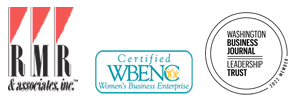Below is an article from RMR’s President and CEO Robyn Sachs that shows the value of effective sales presentations and serves as a great resource for companies looking to enhance their business.
Sales Presentations that Sell!
At the top of the RMR Marketing Pyramid is sales calls- the most expensive marketing method but also potentially the most effective. Assuming you aren’t cold calling door-to-door, once you’re in a sales call you have narrowed down and qualified the lead to the point that you know you’ll be presenting to a potential customer. Now it’s up to you to close the deal with a dynamite sales presentation that makes them eager to buy what you’re selling. From PowerPoint presentations to webinars, the point is to enhance your message, not obscure it.
Whoa! What do they need to know?
It’s easy to get carried away and overwhelmed by colors and fonts and music and special effects. But even a whiz-bang presentation can leave viewers wondering what the whole thing meant – and that means you wasted your time and money putting it together. So the first step is to ask yourself this one question:
What do they need to know to say, “yes” to what I’m selling?
Do they need to know how humorous and entertaining you are? How talented you are with presentation tools? While these can break the ice and add levity to the presentation, they aren’t the most important issues. They really need to know what’s better about your product or service and what you can do for them that others can’t.
This calls for an outline.
If you, like many others, still dread this word from high school English class, rest easy. An outline can be a simple list of bullet points you need to cover, placed in the order that makes the most sense. What are the Key Messages you need to convey to get the sale? Once you’ve created your basic outline, go back and enhance each point with facts that back up or elaborate on each message. There you have it – your presentation in a nutshell. Of course, if that were all you needed to sell today, you could go into sales calls with some notes on a piece of paper and a contract to sign. Today’s savvy buyers expect a bit more from sales presentations.
Tell them a story.
Just as good speakers open with an anecdote or pepper their speech with examples, case studies and customer stories make good sales presentations even better. People perk up when they realize a story is coming; they listen and remember it. Use the problem/solution/results format but keep it interesting and to the point. A story should illustrate and enhance your point while allowing an easy transition to your next point.
Jazz it up – But keep it simple.
You’ve heard the expression “Less is more” right? From Power Point presentations to Webinars, the secret is to enhance your message, not overwhelm it. Eager presenters consistently make the same two big errors: packing their slides with too much text, and using so many bells and whistles that the message itself becomes obscured.
Mistake Number One: Too many words.
Picture yourself on the other side of your presentation. How many full-text slides does it take for your eyes to glaze over and your mind to wander?
Imagine that each slide is a roadside billboard. That’s about how much information most minds can take in at one time. The billboard rule is to use six words or less. But not every slide could or should be this short. A slide with three short bullet points is manageable, but six is probably too many.
Which of your Key Messages could be illustrated by a simple chart or graphic? Diagrams force the viewer to interact with you by studying the illustration, and this interaction makes it memorable. Then again, if every slide contained a chart or graph that would then become routine. The best presentations vary their format with different types of slides to keep it interesting and engaging and these images support your main message points.
Mistake Number Two: Too many bells and whistles.
Using all the tools at your fingertips may make your presentation dazzle, but it’s likely to make your sales fizzle. Think about the TV commercials that are so hilarious you laugh and laugh but can’t remember the advertiser or product. Using too many fonts, colors, sound effects and animations can distract people from your message.
Generally it’s wise to use no more than two fonts and two accent colors throughout the presentation so they perk up rather than confuse your layouts. Use sound effects and music for the “surprise” factor – not for background noise. Animation? It’s a lot like a smiley face. Not everyone appreciates it, and some find it annoying. Use it if you know your audience well and know they will be comfortable with it. But if you’ll be presenting to a variety of audiences you may not know, it may be best to leave out the animation, or use it sparingly and well.
White space sells.
A presentation that’s absent of clutter is simple, direct, and conveys the subliminal message that what you’re selling is good enough to stand on its own. It doesn’t need to be sweetened or camouflaged, just enhanced to make it memorable. So start with your basic message. Enhance some points with stories, charts and graphs, while leaving others to shout their simple, powerful message like a billboard. Then pull out your contract and pen and prepare to close the deal.
